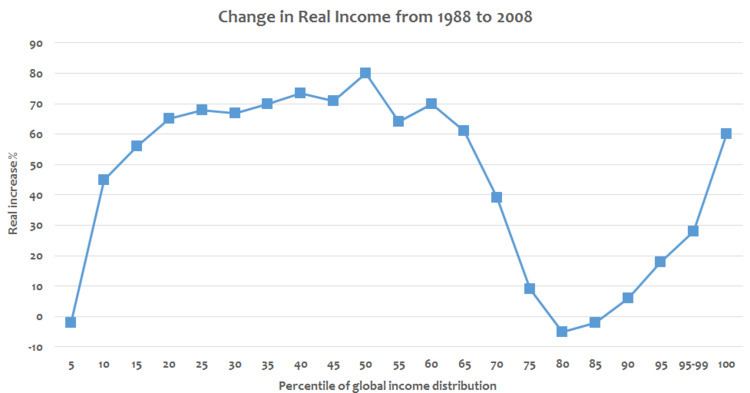 | ||
International inequality refers to economic differences between countries. According to the United Nations Human Development Report 2004, the gross domestic per capita (GDP) in countries with high, medium and low human development (a classification based on the UN Human Development Index) was 24,806, 4,269 and 1,184 PPP$, respectively (PPP$ = purchasing power parity measured in United States dollars).
Contents
International wealth distribution
A study by the World Institute for Development Economics Research at United Nations University reports that the richest 1% of adults alone owned 40% of global assets in the year 2000, and that the richest 10% of adults accounted for 85% of the world total. The bottom half of the world adult population owned barely 1% of global wealth. In 2013, Oxfam International released a report to The World Economic Forum that the richest 1% owns 48 percent of the global wealth. In 2014, Oxfam reported that the 85 wealthiest individuals in the world have a combined wealth equal to that of the bottom 50% of the world's population, or about 3.5 billion people. More recently, in January 2015, Oxfam reported that the wealthiest 1 percent will own more than half of the global wealth by 2016.
The major component of the world's income inequality (the global Gini coefficient) is comprised by two groups of countries (called the "twin peaks" by Quah [1997]).
Economic inequality often closely matches a lognormal or Pareto distribution both across economies and within them.
The evolution of the income gap between poor and rich countries is related to convergence. Convergence can be defined as "the tendency for poorer countries to grow faster than richer ones and, hence, for their levels of income to converge". Convergence is a matter of current research and debate, but most studies have shown lack of evidence for absolute convergence based on comparisons among countries.
According to current research, global income inequality peaked approximately in the 1970s when world income was distributed bimodally into "rich" and "poor" countries with little overlap. Since then inequality have been rapidly decreasing, and this trend seems to be accelerating. Income distribution is now unimodal, with most people living in middle-income countries.
Comparisons
Some of the economic disparities among nations can be better appreciated when rich and poor countries or societies are contrasted. For example, with regard to income inequality, according to some estimates by Branko Milanovic from the World Bank:
With regard to wealth inequality (researchers defined wealth as the value of physical and financial assets minus debts), a 2006 report with data from 2000 concluded that:
James Davies, Professor of Economics at the University of Western Ontario, and one of the authors of the report, said: "Income inequality has been rising for the past 20 to 25 years and we think that is true for inequality in the distribution of wealth." "There is a group of problems in developing countries that make it difficult for people to build assets, which are important, since life is so precarious."
Other disparities can be better appreciated when rich individuals (or corporations) are compared against poor individuals. According to some estimates, for instance:
Additional data
Wealth:
Income:
Welfare spending: If East Asia and southern Latin American countries are taken out of the equation, the differences in government spending between the industrialized and developing is as follows:
Therefore, in contrast to the North, the developing states are far more vulnerable to the pressures arising from economic globalization. Overall, social spending is far lower in the South, with some regions registering just a few percentage points of GDP. However, some people argue that decrease in welfare spending is not an issue of global inequality but rather a common phenomenon in an era of globalization.
Views on economic inequality
There are various schools of thought regarding economic inequality. Marxism favors an eventual society where distribution is based on an individual's needs rather than social class or other such factors. Meritocracy favors an eventual society where an individual's success is a direct function of contribution reflecting an individual's skills and effort, and detrimental (this is a value judgement) inasmuch as it represent inherited or unjustified wealth or opportunities. Classical liberals and libertarians generally do not take a stance on wealth inequality, but believe in equality under the law regardless of whether it leads to unequal wealth distribution. Arguments based on social justice favor a more equal distribution making claims economic inequality weakens societies, although counter-arguments are made that inequality might benefit societies.
